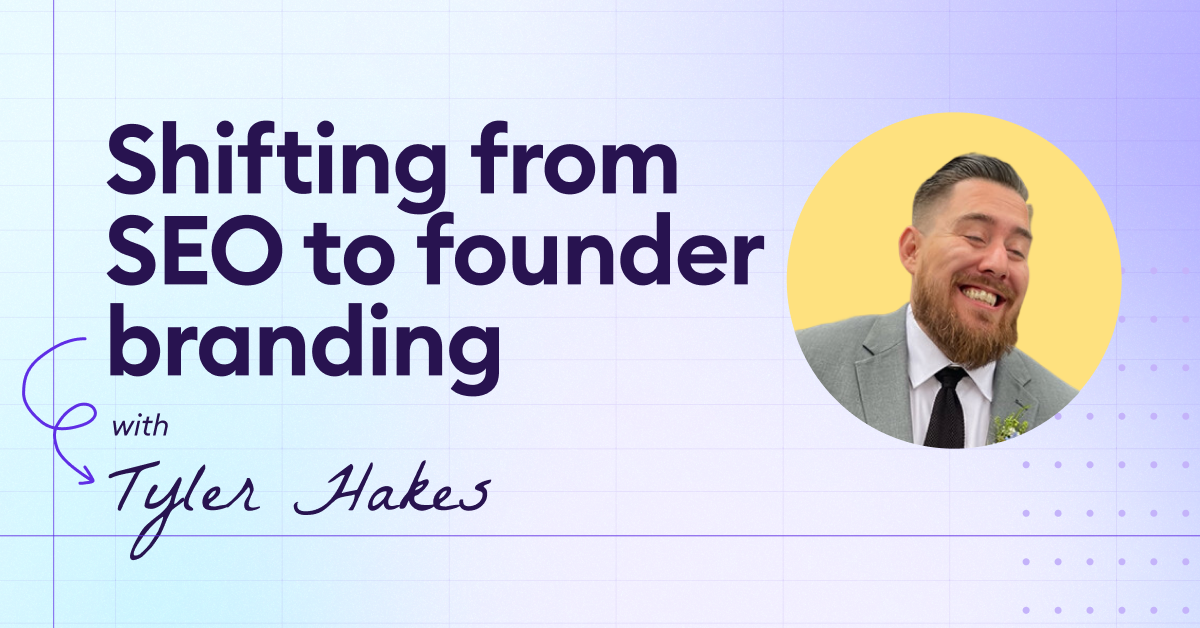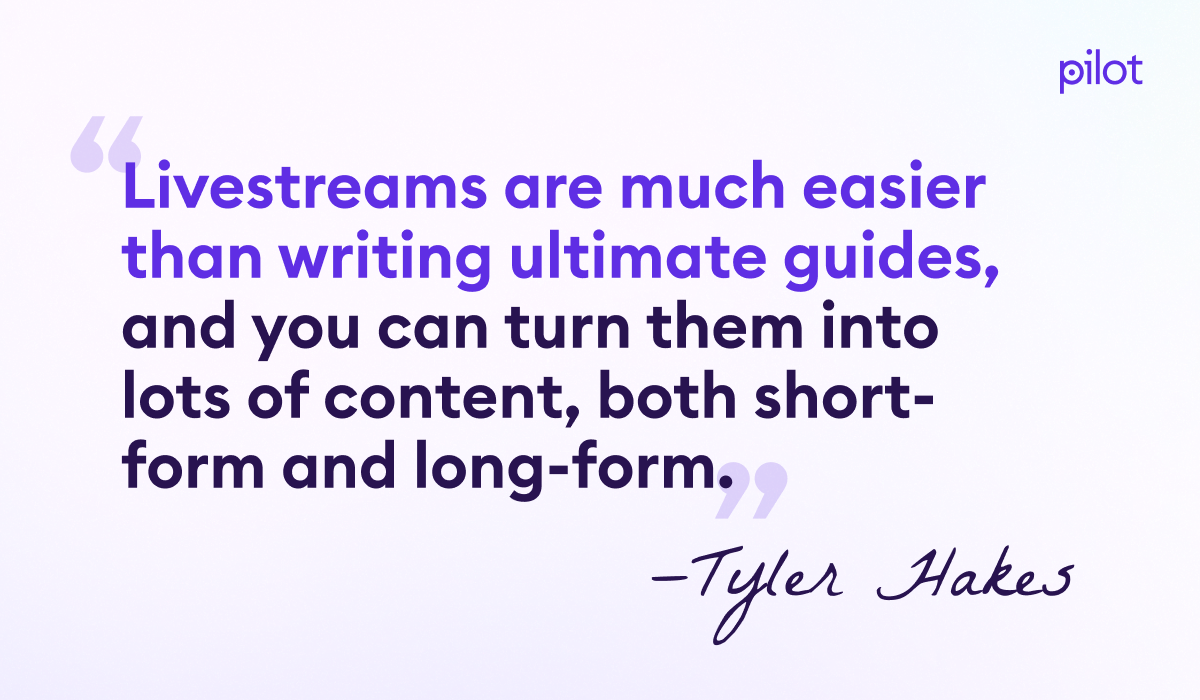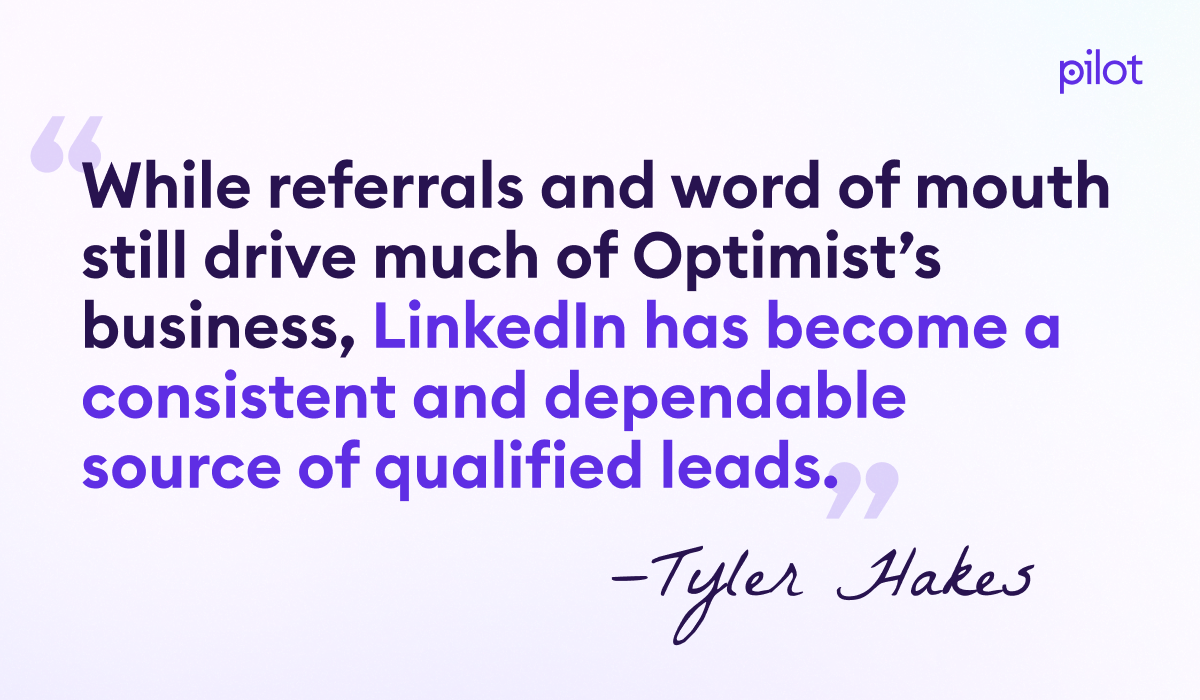How Tyler generated a $500K new deal for his agency through brand-building on Linkedin

How many times have you published an article, shared it once on LinkedIn, and moved on? For many agency owners, that’s the extent of their personal branding on that platform.
And that’s how Tyler Hakes, founder of Optimist, a content agency with clients like Superhuman, Semrush, and ZoomInfo, approached LinkedIn. “I didn’t take it seriously,” he says.
But once he started showing up more intentionally and commenting to create a conversation, he began generating steady inbound leads that have more than offset the general decline creative agencies are feeling from other marketing channels. In 2024, Optimist surpassed $1 million in annual revenue, bringing its lifetime revenue to nearly $8 million with a 7% EBITDA margin. And after attracting one new LinkedIn-sourced opportunity worth nearly half a million dollars per year, that number is likely to grow.
In this article, we share how Tyler is building his founder brand on LinkedIn and what we can all learn from his approach.
Want to improve your margins? Give our agency profit calculator a try.
Success story: How one agency got clear on their true hiring costs →
When SEO stalled, Tyler turned to LinkedIn
When Tyler started his agency nearly a decade ago, the idea of “building in public —openly sharing how you’re creating your business or product—was popular, thanks to companies like Baremetrics and Buffer. Inspired by their transparency and wanting to hold himself accountable, Tyler began documenting the growth of Optimist from day one.
Tyler wrote candidly about what it was like to run a content marketing agency, sharing annual revenue numbers, business milestones, team structure, and even internal struggles. For example, he published a breakdown of how the agency scaled to $1.5 million in revenue in three years without any managers, and a transparent analysis of the flaws in their sales process. His team also contributed regularly, offering their own perspectives on what it was like to work at Optimist and the challenges they faced
This approach was great for building the Optimist brand and increasing awareness, but over time, Tyler began to rethink the strategy for two key reasons.
First, much of that content lived on their blog or Reddit, which was great at first because he optimized the articles for search engines, and people discovered them on Google. But SEO is now less predictable and reliable, so those posts perform less well.
Second, the content mostly resonated with other founders, freelancers, and early-stage entrepreneurs, not Optimist’s ideal customers. Tyler’s latest yearly update on Reddit, for example, gained traction, but the comments were largely from fellow business owners who related to his story, not from potential customers.
“That [blogging] has never really been a marketing strategy for Optimist, per se. But it increased our visibility, which helped in an indirect way,” says Tyler.
So, Tyler switched. He began focusing more intentionally on LinkedIn, building a founder brand to connect directly with potential clients and get more leads. “We've needed to diversify our own marketing strategy and really focus on how we build my brand and also our brand as an agency to build connections and generate pipeline,” he says.
Tyler’s strategy: Be educational, practical, and promotional—in that order
Tyler follows a loose version of the 70-20-10 rule for content. Around 70% of his posts are focused on educating or engaging his audience. Another 20% offer practical advice or solutions. And only about 10% of his content is directly promotional, inviting people to join his community, sign up for an event, or consider working with Optimist.
This ratio allows him to offer enough value that when he makes requests, people are only eager to oblige because they’ve benefited from his posts.
How does he decide what to share? At any given time, Tyler works within a set of 3-5 core themes. These often include content marketing, SEO, agency growth, and AI. He creates content around those themes every month or so, exploring them from different angles and using varied formats to pass his point across.
For example, one of his current themes is AI and Artificial Intelligence Optimization (AIO), and in the last few weeks, he’s posted about:
- Why we shouldn’t repeat the same mistakes with AIO that we did with SEO
- His skepticism of AI/LLM visibility studies
- A framework for brand positioning in LLMs, etc.
This theme-driven approach gives him the space to explore complex topics in depth and stay relevant to his audience.
Beyond written posts, Tyler has leaned more into video content and live events. As a founder with limited time, he finds it a more efficient way to produce content that can be repurposed into multiple formats.
“Livestreams are much easier than writing ultimate guides, and you can turn them into lots of content, both short form and long form," says Tyler.

Optimist’s live events and videos generate leads for the agency in a way past Reddit posts did not. During a recent one, two prospects submitted inquiries during the session. Other live events have sparked conversations among their exact marketer buyers on LinkedIn.
While referrals and word of mouth still drive much of Optimist’s business, LinkedIn has become a consistent and dependable source of qualified leads. Tyler sees a direct impact as long as he’s posting, and one of those leads turned into a client worth nearly $500,000 per year.

When a post converts, it’s because the prior nine built trust
Building a brand on LinkedIn takes time to pay off, and really hinges on being generous with your ideas. “For me, it's really more about the long-term strategy. How do we build relationships and connections that will turn into work a year from now or five years from now?... And [LinkedIn] has definitely created a lot of connections and networking opportunities.”
Tyler posts regularly, at least three times a week, and sometimes as often as seven. Occasionally, the value comes in the form of a direct message—but even more of it comes from converting people to Optimist’s newsletter and Slack community, “Top of Funnel.” You can’t predict or forecast it. But over time, being generous, present, and supportive on LinkedIn has paid off.
“It’s not like it's driving millions of leads or anything like that,” Tyler says. “But it has kept a steady stream of new leads coming in, which has helped offset the decline we’ve seen from our usual marketing channels.”

Lessons from Tyler’s story
- Select 3-5 core themes.
- Block off time to post at least twice a week.
- Build a backlog of ideas as you go.
- Host webinars or livestreams and repurpose them.
- Avoid cheap engagement hacks—aim to add value.
- Use LinkedIn to grow your email list.

Just start
If you’re not building a founder brand, now might be the time to start—but do as Tyler did, and really stick with it. Set up your work environment so it becomes part of your day. Block out an hour this week to write a LinkedIn post about your thoughts on the industry trends. Or share a lesson from your work with a recent client. Then make it a habit to continue sharing.




.png)
.jpg)